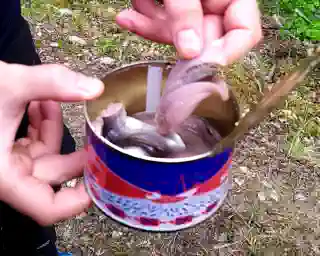
Flashback: 10 Dinge die wir in Schweden gelernt haben
Schweden war nicht nur unser erstes Reiseziel, sondern auch eines der entspanntesten Länder, die wir in Europa besucht haben. Schweden zeichnet sich durch seine Wälder, Seen und Flüsse, die Mitternachtssonne, Mücken und Elche, Midsommar und Zimtrollen mit Kardamom aus. Schweden ist für uns zu so vielem geworden, aber vor allem ist es ein Sommermärchen, das uns auch im Nachhinein immer noch so erscheint. Um euch einen kleinen Einblick in dieses wunderschöne Land zu geben, stellen wir euch hier die 10 Dinge vor, die wir in Schweden gelernt haben.

Flashback: Unser Start in Schweden
Wir haben über 5 Wochen in Schweden verbracht und dabei das gesamte Land von Süd nach Nord und wieder zurück erkundet. Der Sommer, den wir hier verbracht haben, war nicht nur ein entspannter Start unserer Reise, sondern auch eine unvergessliche und intensive Zeit für uns. Es war genau das Camping-Erlebnis, das wir uns immer vorgestellt haben: Lagerfeuer am Fluss, morgendliches Schwimmen im See und anschließend den herrlichen Blick genießen, begleitet von Glücksmomenten mit Rehen oder Elchen. Wir sind viel gewandert und können es jedem nur empfehlen, sich auch mal von seinen Füßen tragen zu lassen, da die Wandergebiete in Schweden hervorragend ausgebaut sind. Also packt unbedingt ein Zelt, einen Schlafsack und gute Wanderschuhe in euer Gepäck.
In den 5 Wochen haben wir viele unvergessliche Erlebnisse gehabt. Wir haben den ältesten Baum der Welt besucht und ihn nach seiner Meinung zur Klimaerwärmung gefragt. Außerdem sind wir zum ersten Mal stecken geblieben und haben die erste Kanutour mit Momo unternommen. Wir haben zwar einige Dinge verloren, aber wir sind dadurch nicht ärmer geworden. Ganz im Gegenteil, wir haben durch die Natur und die Mitternachtssonne nur gestaunt. Nach all diesen Erfahrungen haben wir uns am Ende gefragt, was wir eigentlich von diesem Land mitgenommen haben. Das brachte uns dazu, die 10 Dinge zu identifizieren, die für uns typisch für Schweden sind. Vorher waren uns diese Dinge gar nicht so bewusst, aber jetzt teilen wir sie gerne mit dir.
1. Falunrote Häuser
Diese charakteristischen, in Falunrot gestrichenen Häuser findet man überall in Schweden und sie sind nicht nur in den Bilderbüchern von Astrid Lindgren zu sehen. Sie verleihen Schweden einen klassischen und typischen Look, den wir bereits aus den Büchern von Astrid Lindgren oder Sven Nordqvist kennen, jedoch erst jetzt so richtig bewusst wahrgenommen haben. Was besonders schön ist, ist die Tatsache, dass dieser schöne Trend sich ausweitet. So findet man nicht nur Häuser in Falunrot, sondern auch Hundehütten und Plumsklos in dieser Farbe. Dieser Stil erstreckt sich übrigens über das gesamte Land, auch bis in den Norden.
2. Surströmming
Wenn es um typisch schwedische Delikatessen geht, fallen in Deutschland oft Begriffe wie Köttbullar oder Smörgåsbord. Doch bei den Gerichten, die man auf jeden Fall NICHT essen sollte, steht ganz oben: Surströmming. Unsere Surströmming-Erfahrung: Surströmming bedeutet übersetzt saurer Hering und bezieht sich auf eingelegten Fisch. Wer nicht weiß, worum es dabei geht, sollte sich auf Videoplattformen passendes Videomaterial anschauen, denn für eine Weile war es anscheinend eine Art Wette, diese “Delikatesse” zu essen. Allerdings kann man diese Art der Nahrungsaufnahme kaum als Essen bezeichnen, und auch uns hat dieser Fisch einiges abverlangt.
An unserem wöchentlichen Einkaufstag, an dem wir unsere Vorräte wieder auffüllen, hat Georg endlich eine der lang ersehnten Surströmming-Dosen ergattert. Die Dose sah auf den ersten Blick harmlos aus, war jedoch etwas größer, als ich erwartet hatte. In den letzten Wochen hatte Georg immer wieder Ausschau danach gehalten, da er es unbedingt probieren wollte. Schließlich kennen wir eingelegten Fisch von zu Hause, also konnte eingelegter Fisch aus Schweden ja nicht so schlimm sein, oder?!
Der Druck auf der Dose war etwas, das Georg völlig vergessen hatte, als er sie IM Bus öffnete. Plötzlich spritzte Surströmming-Wasser aus dem ersten Loch der Dose. Ein abscheulicher Gestank verbreitete sich im Bus. Es sollte erwähnt werden, dass aufgrund des Drucks auf den Dosen, sie auch im Flugzeug verboten sind. Wer einmal diesen Geruch in der Nase hatte, wird dieses Verbot sicherlich zu schätzen wissen. Schließlich möchte niemand einen Sitznachbarn haben, der gerade so etwas isst! In Panik sprang Georg mit der immer noch spritzenden Dose aus dem Bus an mir vorbei.
“Man kann das nicht essen, wer das isst, frühstückt auch kleine Kinder”
wiederholte Georg immer wieder und versuchte dabei so wenig wie möglich durch die Nase zu atmen.
Ich kann mir auch nicht vorstellen, dass irgendjemand freiwillig dieses Zeug isst. Inzwischen haben wir eine Theorie entwickelt: Die Schweden machen sich über die Welt lustig. Sie kreieren das widerlichste Essen der Welt und behaupten dann, es sei eine Delikatesse. Und schon kommen Touristen aus aller Welt und machen sich lächerlich. Vielleicht ist es ein Streich, und wir waren mitten drin.
Wir versuchten, die geöffnete Dose in Plastiktüten zu verpacken, da der Geruch bereits unerträglich war. Das war jedoch nicht so einfach, denn der Geruch war wirklich schrecklich… außer für Momo, die es unglaublich interessant fand und unbedingt auch einmal probieren wollte.
Während der ganzen Prozedur beschwerte sich Georg immer wieder darüber, wie eklig das alles sei und dass er es auf keinen Fall noch einmal essen würde, bis es mir zu viel wurde. Ich muss sagen, dass ich sowieso kein großer Fischesser bin. Und dann auch noch mit Haut. Und dann noch eingelegt. Und dann auch noch Surströmming. Es war wirklich nicht gut.
Geschmacklich war der Fisch genauso schlimm wie der Geruch vermuten ließ. Es war eine widerliche Mischung aus verfaultem Fisch, faulen Eiern und Erbrochenem. Ob man ihn so isst oder mit Kartoffeln auf Brot legt, spielt geschmacklich keine Rolle. Es wäre nur schade um das Brot. Ich möchte euch die genauen Details ersparen, aber mein Körper versuchte diesen Fremdkörper schnell wieder loszuwerden.
Natürlich musste Georg, nachdem ich vorgelegt hatte, den Fisch auch essen, und das hat er tatsächlich getan. Auch er hatte mit dem Fisch zu kämpfen. Am Ende liefen wir beide im Schlafanzug noch durch den Wald, und wahrscheinlich klebte der Geruch von Surströmming an uns, genauso wie der Bus noch Tage später danach roch.
Ja, der Fisch ist abscheulich, und ich glaube, niemand möchte ihn essen. ABER:
Trotzdem – einmal im Leben sollten auch Sie Surströmming probiert haben. Warum? Weil es Sie stolz machen wird. Weil es Ihnen das Gefühl geben wird, etwas gewagt zu haben – ohne dass Sie irgendwo runter springen oder sich sonst wie in Lebensgefahr begeben mussten. Wenn Sie eine Dose Surströmming öffnen, sehen Sie dem Tod nicht ins Auge. Aber Ihnen wird klar, wie er riecht.
3. Å
Tatsächlich wird das Buchstabe “Å” im Schwedischen wie ein “O” ausgesprochen. Es ist jedoch seltsam, dass die Schweden sowohl “Å” als auch “O” verwenden. Warum das so ist, konnten wir bisher leider nicht herausfinden.
4. Autofahren
In Schweden wird das Autofahren im Vergleich zu Deutschland oft als entspannter und angenehmer empfunden. Es macht richtig Spaß, hier Auto zu fahren, da man selten gedrängelt oder bedrängt wird. Die schwedischen Fahrer sind bekannt dafür, sehr entspannt unterwegs zu sein.
5. Dill
Dill wird in Schweden oft als Hauptwürze in verschiedenen Gerichten verwendet wird. Es scheint, als ob die Schweden der Meinung sind, dass Dill allein ausreicht, um einem Lebensmittel Geschmack zu verleihen. Jedoch empfehlen wir, einen Bogen um Dillchips und Fisch in Dillsoße zu machen, es sei denn, man ergänzt sie zusätzlich mit Salz, Pfeffer und Zitrone. Leider werden diese Zutaten oft in der Zutatenliste vernachlässigt.
6. Und noch ein Gewürz: Kardamon
Kardamom ist eine häufig verwendete Zutat in Hefegebäck, insbesondere in den berühmten Kanelbullar (Zimtschnecken). Es verleiht diesen Gebäcken einen einzigartigen und köstlichen Geschmack. Aber nicht nur in Kanelbullar, sondern auch in vielen anderen Hefeteiggebäcken wird Kardamom verwendet. Es ist definitiv ein unvergesslicher Geschmack, der es wert ist, nachgeahmt zu werden. Wenn du also das nächste mal ein Hefegebäck selber machst, versuch doch mal Kardamom hinzuzufügen. Es lohnt sich!

7. Das Plumpsklo
In Deutschland ist das Plumpsklo jedoch weitgehend in Vergessenheit geraten oder sogar verbannt worden. Warum das so ist, lässt sich nicht eindeutig feststellen. In Schweden hingegen findet man Plumpsklos an vielen Orten, und sie sind oft sauber, geruchsfrei und gut gepflegt. Einige von ihnen sind sogar so prunkvoll gestaltet, dass man fast den Eindruck hat, auf einem Thron zu sitzen. Plumpsklos sind eine großartige Methode, um zu verhindern, dass Taschentücher oder noch schlimmer, Feuchttücher, nach der Benutzung im Wald landen.
Der Einsatz von Plumpsklos trägt zur Sauberkeit und zum Schutz der Natur bei, da keine verschmutzten Hygieneartikel in der Umwelt zurückgelassen werden. Sie sind eine umweltfreundliche Alternative zu herkömmlichen Toiletten, insbesondere in Gegenden, in denen eine Kanalisation nicht verfügbar ist.
Es ist interessant zu sehen, wie unterschiedlich der Umgang mit Toilettenkulturen in verschiedenen Ländern sein kann. Während das Plumpsklo in Schweden weiterhin weit verbreitet und gepflegt ist, hat es in Deutschland an Popularität verloren.
8. Schlange stehen
Es ist faszinierend, wie Schlange stehen in Schweden so beliebt ist. Jeder respektiert hier die Gleichheit und fügt sich in das Bild der Gemeinschaft ein. Ein besonderes Erlebnis war es, das Reißverschlussverfahren zu beobachten. Zugegeben, auch bei uns funktioniert dieses Verfahren nicht immer reibungslos. Doch hier scheint es nicht zu funktionieren, weil sich die Menschen lieber ordentlich anstellen, anstatt bis ganz nach vorne zu fahren und dann einzufädeln. Das ist wirklich bemerkenswert. Es ist schön zu sehen, wie die Schweden diese Art des Miteinanders praktizieren. Uns hat es vorallem gezeigt, dass kleine Verhaltensänderungen einen großen Unterschied machen kann und zu einem angenehmeren Fahrerlebnis für alle beitragen kann.
9. Lagom
Das Wort “lagom” hat in der schwedischen Sprache eine besondere Bedeutung. Es steht für etwas, das genau richtig ist - weder zu viel noch zu wenig. Man kann es verwenden, um zum Beispiel die perfekte Trinktemperatur von Kaffee zu beschreiben. Ein Beispielgespräch könnte wie folgt aussehen:
- “Wie ist dein Kaffee, ist er zu heiß?”
- “Nein, er ist lagom.”
- “Also auch nicht zu kalt?”
- “Nein, er ist lagom.”
“Lagom” bedeutet also, dass etwas genau richtig ist. Es muss nicht perfekt sein, sondern einfach in der richtigen Balance. Es geht darum, ein angemessenes Maß zu finden und sich in der Mitte zu befinden, weder zu viel noch zu wenig. Es ist eine Mentalität des Ausgleichs und der Zufriedenheit, die in Schweden geschätzt wird.
10. Das Jedermannsrecht
Auch bekannt als “Allemansrätten”. Dieses Recht hat unsere Reise so besonders und unkompliziert gemacht. Wir haben nur zweimal Campingplätze aufgesucht und die anderen Nächte immer frei gestanden. In Schweden beinhaltet dieses Recht, dass jeder Mensch die Natur genießen darf, unabhängig von ihrem Eigentümer. Insbesondere das Zelten ist daher in Schweden sehr einfach. Beim Übernachten im Auto wird dies meistens ebenfalls akzeptiert.
Allerdings gilt: Wer Rechte hat, hat auch Pflichten! Deshalb war es für uns besonders wichtig, uns bewusst zu sein, dass wir Gäste in diesem Land sind. (Das gilt für uns überall!!!)
Wir leben so, dass wir keine Spuren hinterlassen, nichts beschädigen, keine Verschmutzung verursachen und niemand anderen stören oder schädigen. Das ist uns von großer Bedeutung, und genauso werden wir auch weiterhin unsere Reise gestalten.







